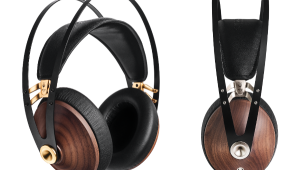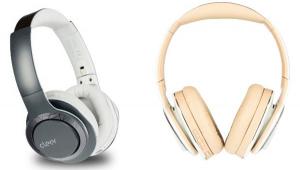Fuse InTune Headphones: Tuned to Your Taste Page 2
Here’re the results I got with each headphone:
Jazz/Classical: Nicely balanced, natural-sounding mids and highs. This is about the level of performance I’d expect from a good $25 in-ear headphone. To my surprise, though, the bass sounded unnaturally pumped up and a little “fat” and undefined — not a sound I associate with jazz or classical, more like an old-school R&B/soul kind of bass.
Hip-Hop/Rap: The weirdest-sounding headphone I’d ever heard. It sounds like a speaker run through a 3-inch ABS pipe then muffled through a pillow. Or like the sound of a pumped-up car stereo when the windows are rolled up and you’re outside the car. The midrange is extremely colored, like the singer is using a megaphone. There’s a big emphasis on upper bass, but not much deep bass to speak of. This isn’t a sound I associate with hip-hop (much of which is quite well-recorded).
Pop/Easy Listening: This category I don’t get — like the same headphone is supposed to sound right for Ke$ha and Perry Como? Anyway, this one has some of the midrange coloration of the Hip-Hop/Rap model, but a more even and open sound. The treble seems slightly boosted and a bit overly crisp; cymbals sound like they’re made from steel rather than brass. It does make pop tunes sound a little, well, poppier.
Rock/Blues/Country: This one has a rather thin tonal balance, but plenty of bite in the midrange. It seems like it was voiced to make rock guitar sound more kick-ass. It certainly did the most to bring out the guitars (and even the nearly buried keyboard parts) in “Dancing Days,” but Zep’s inimitable groove was lost.
Some quick measurements with a simple tube coupler (not what you’d call a reference measurement, but adequate for the purpose of comparison) comfirmed much of what I was hearing. The jazz/classical model (blue trace) has by far the flattest response but with a very audible bass boost at 40 Hz. The hip-hop/rap model (red trace) has an upper-bass boost at 100 Hz but not much low bass, and a big notch at 550 Hz. The pop/easy listening model has some treble boost and a notch at 700 Hz. The rock/blues/country model has a less-extreme notch at 550 Hz and a bass boost at 30 Hz, which isn’t as audible as the jazz/classical model’s 40 Hz boost. (The lowest note on a standard electric or upright bass is 41 Hz.)
After auditioning all the InTunes, I can’t buy into the concept of particular voicings for particular kinds of music — in fact, IMHO the jazz/classical InTune sounded better than all the other ones no matter what music I played. But there’s the genesis of a great idea here: How about a line of headphones with slight timbral adjustments? Start with one that’s flat and neutral. Then do one with just a little more oomph at 40 Hz, one with a mildly uptilted treble and one with a bit of midrange boost. And tell us on the packaging exactly what the headphones do, rather than couching it in a genre or making us extrapolate based on which celebrity endorsed the headphone. InTunes goes part of the way there — the response curves are printed on the packaging — but it’s still confusing even for a guy like me who looks at frequency response graphs every day.
- Log in or register to post comments





























































